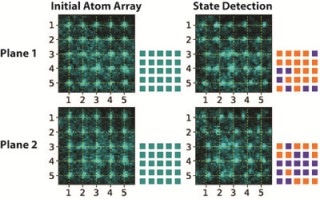Mar 26 2019
A new technique enables measurement of the quantum state of atomic “qubits,” which are the basic unit of information in quantum computers, with 20 times less error compared to what was possible earlier, and that too without the loss of any atoms.
 New method allows extremely accurate measurement of the quantum state of atomic qubits—the basic unit of information in quantum computers. Atoms are initially sorted to fill two 5 x 5 planes (dashed yellow grid marks their initial locations). After the first images are taken, microwaves are used to put the atoms into equal superpositions of two spin states. A shift to the left or right in the final images corresponds to detection in one spin state or the other. Associated square patterns denote atom locations (cyan: initial position, orange and blue: shifted positions). (Image credit: Weiss Laboratory, Penn State)
New method allows extremely accurate measurement of the quantum state of atomic qubits—the basic unit of information in quantum computers. Atoms are initially sorted to fill two 5 x 5 planes (dashed yellow grid marks their initial locations). After the first images are taken, microwaves are used to put the atoms into equal superpositions of two spin states. A shift to the left or right in the final images corresponds to detection in one spin state or the other. Associated square patterns denote atom locations (cyan: initial position, orange and blue: shifted positions). (Image credit: Weiss Laboratory, Penn State)
Accurate measurement of qubit states, which are similar to the one or zero states of bits in conventional computing, is a crucial step in developing quantum computers. A study illustrating the technique by scientists at Penn State was published in the Nature Physics journal on March 25th, 2019.
We are working to develop a quantum computer that uses a three-dimensional array of laser-cooled and trapped cesium atoms as qubits. Because of how quantum mechanics works, the atomic qubits can exist in a ‘superposition’ of two states, which means they can be, in a sense, in both states simultaneously. To read out the result of a quantum computation, it is necessary to perform a measurement on each atom. Each measurement finds each atom in only one of its two possible states. The relative probability of the two results depends on the superposition state before the measurement.
David Weiss, Professor of Physics, Penn State.
Weiss is also the leader of the research team. The researchers measured the qubit states by first using lasers to cool and trap nearly 160 atoms in a 3D lattice with x, y, and z axes. At first, the lasers trapped all the atoms identically, without regard to their quantum state. Then, the team rotated the polarization of one of the laser beams that produces the x lattice, which spatially shifts to the left atoms in one qubit state and to the right atoms in the other qubit state.
Upon starting in a superposition of the two qubit states, atoms end up in a superposition of having moved to the right and having moved to the left. Subsequently, the atoms switch to an x lattice with a smaller lattice spacing, thereby tightly trapping the atoms in their new superposition of shifted positions. Upon scattering light from each atom to take a look at where it is located, each atom is either observed to be shifted right or shifted left, with a probability that is based on its initial state. The measurement of the position of each atom is analogous to the measurement of the initial qubit state of each atom.
Mapping internal states onto spatial locations goes a long way towards making this an ideal measurement. Another advantage of our approach is that the measurements do not cause the loss of any of the atoms we are measuring, which is a limiting factor in many previous methods.
David Weiss, Professor of Physics, Penn State.
The researchers ascertained the accuracy of their new technique by loading their lattices using atoms in either one or the other qubit states and carrying out the measurement. They could accurately measure atom states with an accuracy of 0.9994, that is, there were just six errors in 10,000 measurements, a 20-fold improvement on earlier techniques. Moreover, the number of qubits measured by the researchers in each experiment did not have any effect on the error rate, and since no atoms were lost, it was possible to reuse the atoms in a quantum computer to carry out the next calculation.
Our method is similar to the Stern-Gerlach experiment from 1922—an experiment that is integral to the history of quantum physics. In the experiment, a beam of silver atoms was passed through a magnetic field gradient with their north poles aligned perpendicular to the gradient. When Stern and Gerlach saw half the atoms deflect up and half down, it confirmed the idea of quantum superposition, one of the defining aspects of quantum mechanics. In our experiment, we also map the internal quantum states of atoms onto positions, but we can do it on an atom by atom basis. Of course, we do not need to test this aspect of quantum mechanics, we can just use it.
David Weiss, Professor of Physics, Penn State.
Apart from Weiss, the research group from Penn State included Tsung-Yao Wu, Aishwarya Kumar, and Felipe Giraldo. The U.S. National Science Foundation supported the study.